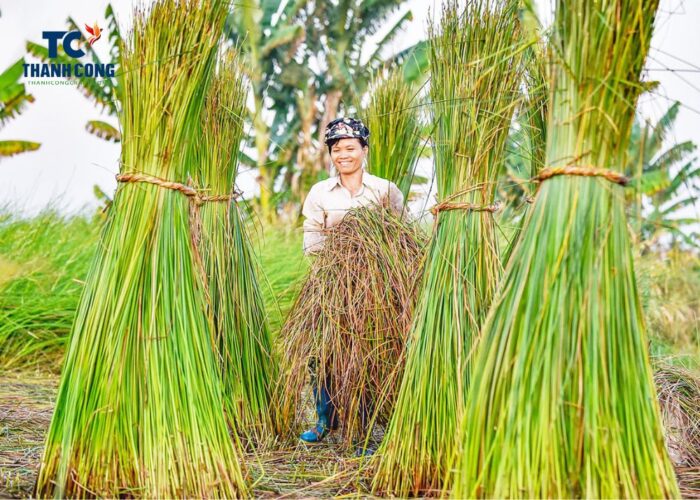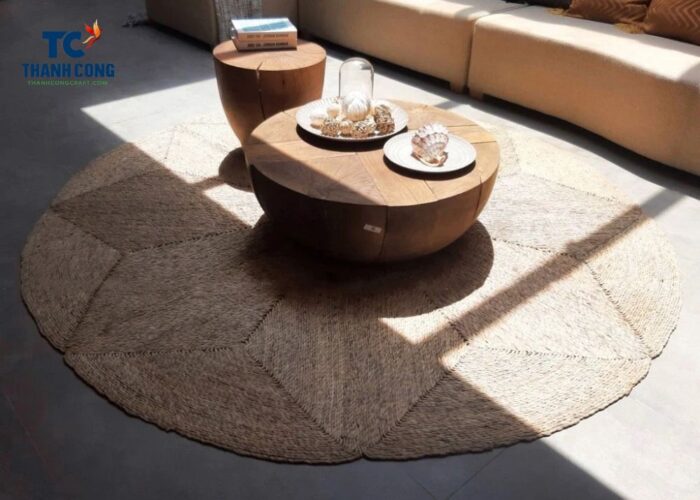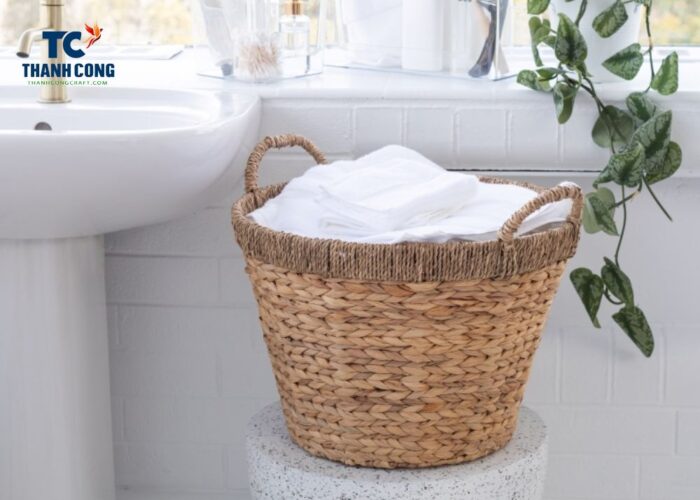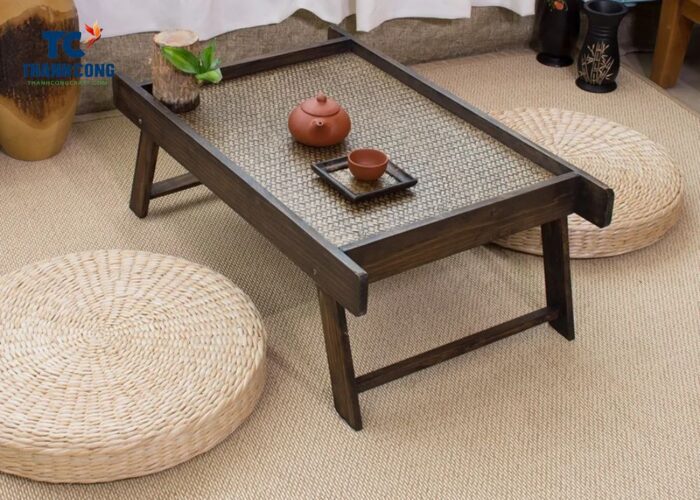Seagrass, a versatile and eco-friendly natural material, has gained widespread popularity in a variety of creative and artistic applications. But what is seagrass material? Join us as we explore this intriguing material and showcase 5 exceptionally popular items crafted from seagrass.
Contents [hide]
1. What is seagrass material?
Seagrass material is made from the fibres of a three-sided, upright plant primarily found in wetland areas. In Vietnam, seagrass grows and is cultivated in northern provinces from Quang Ninh to Thanh Hoa and along the coast of the South Central provinces.
The two main cultivated species are white seagrass (Cyperus difformis) and brown seagrass (Cyperus corymbosus).

Seagrass has the following characteristics:
- High Resilience: Seagrass has a dense but elastic core. When cut across, you can see numerous small fibers inside, resembling foam, providing it with high resilience. This unique structure also gives seagrass its moisture-absorbing properties.
- Durable Lightweight Material: Seagrass is known for being a lightweight yet durable material. Products made from seagrass exhibit flexibility and ease of movement. Moreover, over time, seagrass is resistant to pests and retains its elasticity.
- Flexibility and Delicacy in Design: The natural flexibility and delicacy of seagrass are used in intricate and elaborate design elements, creating an impression of sophistication and gentleness.
- Excellent Moisture Absorption: Thanks to its porous nature, seagrass quickly absorbs moisture, wicking away sweat while remaining dry and providing a certain level of comfort. This natural material offers a comfortable and relaxing sensation, making you feel closer to nature.
- Soft and Easy to Craft: With its pliability and ease of manipulation, seagrass-based products in the market come in various models and types, including cushions, tables, chairs, beds, cabinets, and more. Moreover, due to the growing demand for seagrass products today, designs are continuously improved and upgraded, allowing customers to easily choose products that suit their needs and personal preferences.
2. What is seagrass used for?
Seagrass raw material can be used for various purposes, including handcrafts (seagrass mats, bags, sandals, hats, and many other popular items); erosion control; animal bedding,…
Seagrass finds extensive use in the realm of handicrafts and artistic endeavors, making it suitable for enhancing the aesthetics of spaces ranging from private bedrooms to sunlit garden corners.
Here are 5 exceptionally popular iItems crafted from seagrass:
2.1 Seagrass Rugs
Seagrass rugs are an essential element in our homes. Besides keeping our feet warm on chilly days, seagrass rugs also serve as decor, enhancing the aesthetics of a room. Since seagrass is a natural material, it doesn’t cause skin irritation and is safe for both the elderly and children.

2.2 Seagrass Plate Wall Hanging
Apart from the conventional rugs used for floor decoration, there is another type of seagrass product used for wall hangings and artistic embellishments: Seagrass Plate Wall Hanging. These unique pieces function as attractive fabric tapestries, adding beauty to the wall space.
2.3 Seagrass Plant Baskets
Seagrass baskets for plants offer both aesthetic appeal and an environmentally conscious choice for consumers. These baskets come with the added bonus of the natural fragrance of seagrass. Your room will be filled with a delightful, refreshing scent, reminiscent of a tranquil countryside field at dusk due to the gentle aroma of each seagrass strand. Seagrass baskets also help make small, frequently closed spaces more pleasant.
2.4 Seagrass Baskets
Seagrass Baskets are incredibly useful in daily life, helping you save space and organize your belongings neatly and attractively. Depending on your needs, you can use them to store dirty laundry, children’s toys, household items, and more.

2.5 Seagrass Handbags
Handbags are indispensable accessories for ladies, especially during travels, particularly in coastal areas where seagrass handbags are a must-have. A seagrass handbag with a wrapped handle adds a touch of femininity to an outfit, easily taking a lady from the workplace to a casual date.
3. Can seagrass get wet? Does seagrass get moldy?
Yes, seagrass can get wet as it is a natural fiber that can absorb moisture. Seagrass rugs, baskets, and other products are often used in areas with high humidity or where they might come into contact with water. However, it’s essential to be mindful of excess moisture, as prolonged exposure to water can lead to issues such as mold and mildew growth.
Does seagrass get moldy? Seagrass products can indeed get moldy if they remain damp for extended periods without proper ventilation or drying. Mold and mildew thrive in moist conditions and can develop on seagrass surfaces if not adequately maintained. To prevent this, it’s advisable to keep seagrass products dry, provide good ventilation, and avoid leaving them in consistently damp or humid environments. If you notice mold growth on your seagrass items, it’s essential to clean and dry them thoroughly to prevent further issues.
4. How to preserve seagrass furniture?
Preserving seagrass furniture is essential to extend its lifespan and maintain its appearance. Seagrass furniture can be sensitive to moisture, so proper care is crucial. Here are some tips on how to preserve seagrass furniture:
- Keep it Dry: Similar to other natural basket materials, seagrass can develop mold if exposed to prolonged moisture or stored in damp or humid environments. Therefore, it’s advisable to primarily use seagrass baskets indoors in a dry location. In case your basket does get wet, ensure it dries completely, such as by placing it in direct sunlight.
- Maintain Good Ventilation: All naturally woven baskets benefit from being placed in areas with proper air circulation rather than closed-off rooms. Periodically, consider taking your basket outdoors on a dry, sunny day to keep it looking and smelling fresh.

- Avoid Heavy Loads: While seagrass baskets are aesthetically pleasing, they are not designed for carrying heavy weights. Smaller baskets can typically support around 2-3 kilograms (approximately 4.4 to 6.6 pounds), while larger ones may handle double that weight. If you intend to move a seagrass basket containing a heavy potted plant, it’s best to remove the plant before relocating it.
- Occasional Cleaning: Use a feather duster, bristle paint brush, or a similar tool to gently remove dirt or dust from your basket. A vacuum cleaner with a brush attachment is also effective. For a more thorough cleaning, wipe the basket with a damp cloth. In case of a musty or moldy smell, consider spraying or wiping it with a 1:1 solution of water and white vinegar. Always brush or wipe in the direction of the weave to avoid pushing debris beneath the woven fibers, and allow it to dry completely.
- Addressing Unusual Odors: Some seagrass baskets may emit a grassy odor, particularly when new. While some people enjoy this scent, if you don’t, rest assured that it will naturally dissipate after a few weeks. If you prefer to hasten the process, you can wipe the basket with a 1:1 solution of water and white vinegar or place it in an airtight plastic container with an open box of baking soda for 24 hours. Additionally, allowing your basket to air out outdoors in sunlight can be beneficial.
In conclusion, seagrass material has emerged as a remarkable resource in the world of design and craftsmanship. Its inherent qualities of eco-friendliness, flexibility, and aesthetic appeal have paved the way for its adoption in a wide range of products. From elegant home decor to practical accessories, seagrass has captured the hearts of those who value both style and sustainability.
If you have any further questions, don’t hesitate to send thanhcongcraft an email us at info@thanhcongcraft.com or message us at WhatsApp: +84967485411. Hope to serve you soon! Best regard!


